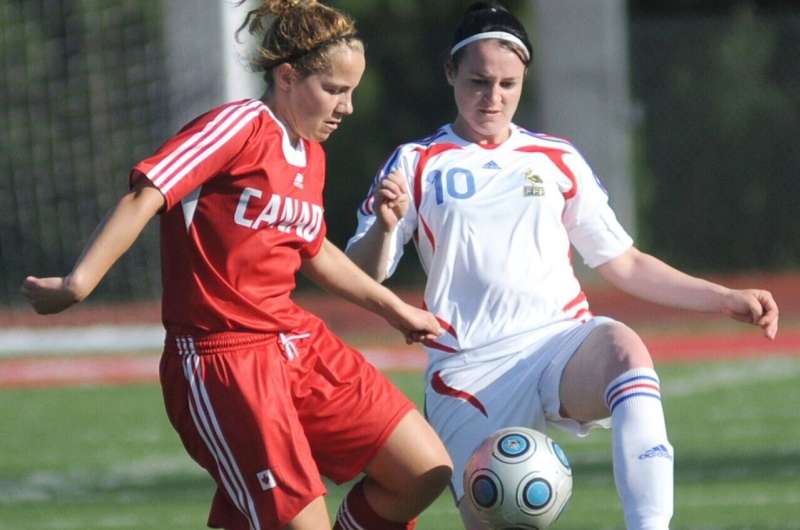Rates of concussions and closed head injuries in teen female athletes over the past 20 years

The epidemiology of sports-related concussions (SRCs) and closed head injuries (CHIs) in high school females remains largely undefined at the national level, especially for unorganized sports and recreational activities such as equestrian and snow-related sports. A new study presented at the 2021 Annual Meeting of the American Academy of Orthopaedic Surgeons (AAOS) took a closer look at sports-related head injuries in female patients over a 20-year period to identify national estimates, demographic characteristics, and trends. The findings show a dramatic increase—more than 200%—in sports-related head injuries among female athletes ages 14-18 and demonstrates that this increase is not always directly correlated to increased participation.
According to studies investigating sex differences in SRC epidemiology, female athletes face concussion rates nearly twice as high as their male counterparts when participating in sex-comparable sports. Female athletes may also be more likely to sustain recurrent concussions, experience atypical symptoms, and require longer recovery times before returning to sport.,
"In addition to concussions, we made sure to include closed head injuries as part of our analysis because, in both cases, we wouldn't want athletes to return to play without an evaluation," said lead researcher Kevin Pirruccio, MD, orthopaedic surgery resident at Yale New Haven Hospital. "CHI is the most common type of traumatic brain injury; it is a blunt, non-penetrating head trauma that doesn't create a break in the skull. While there is a lot of overlap between SRCs and CHIs, concussion refers to the symptoms (dizziness, nausea, blurry vision, etc.) and CHI is the mechanism of the injury."
The study, "Sports-Related Concussions in High School Females: An Epidemiologic Analysis of 20-Year National Trends," retrospectively identified a study population of female patients, ages 14 to 18, who sustained SRCs and CHIs across 56 sports or recreational activities from 2000 to 2019. Dr. Pirruccio and his team used the Consumer Product Safety Commission's National Electronic Injury Surveillance System (NEISS), which documents activity-associated injuries presenting to emergency departments (EDs) in the United States.
"We used the NEISS database because it captured injuries occurring in sports and activities outside of a school setting, such as horseback riding, snowboarding, and rugby, providing a more accurate look at data outside of what is typically studied among high school athletes," said Dr. Pirruccio.
The national weighted estimate of female patients ages 14 to 18 presenting to U.S. EDs with SRCs or CHIs increased significantly between 2000 (9,835 cases) and 2019 (31,751 cases). On average, 39.1% of annual SRCs and CHIs presenting to U.S. EDs occurred in this patient cohort. Over one quarter (26.2%) of these injuries occurred in patients 15 years of age.
Among this group, the five sports and recreational activities most commonly associated with SRCs and CHIs were soccer (20.6%), basketball (18.5%), cheerleading (10.4%), softball (10.1%), and volleyball (6.5%).
As the number of girls participating in sports continues to rise, the research team also studied the direct correlation of increased participation to concussion rates over the 20-year period in high school-aged female athletes. They determined that concussion rates cannot be attributed to increases in participation rates alone. While the primary influence behind increasing concussion trends in these patients may well be increased participation rate for certain sports, such as soccer and volleyball, variations in annual SRCs and CHIs presenting to U.S. EDs associated with softball, cheerleading, and basketball were not strongly correlated with participation.
Dr. Pirruccio and his team hope to further investigate the potential causes of these annual SRC and CHI variations, which could include factors such as concomitant changes in practice rules or training regimens, cultures within a sport, or reporting differences between individual athletes. They also hope this study will encourage other research teams to further investigate the topic.
"While concussions can be classified as an epidemic, it's important to consider that 96.7% of patients who were admitted to the emergency department with an SRC or CHI were treated and went home," said Dr. Pirruccio. "Sustaining a concussion shouldn't necessarily preclude our youth from participating in the sports and physical activities they love. Instead, we hope this study encourages mindfulness among athletes, coaches, and parents and stimulates the adoption of comprehensive return to play protocols to prevent further harm. This is especially important with non-school sanctioned sports and activities, which may lack a dictated return-to-play guideline."
The study was published in Research in Sports Medicine.
More information: Kevin Pirruccio et al, Sports-related concussions in high school females: an epidemiologic analysis of twenty-year national trends, Research in Sports Medicine (2021). DOI: 10.1080/15438627.2021.1954514



















